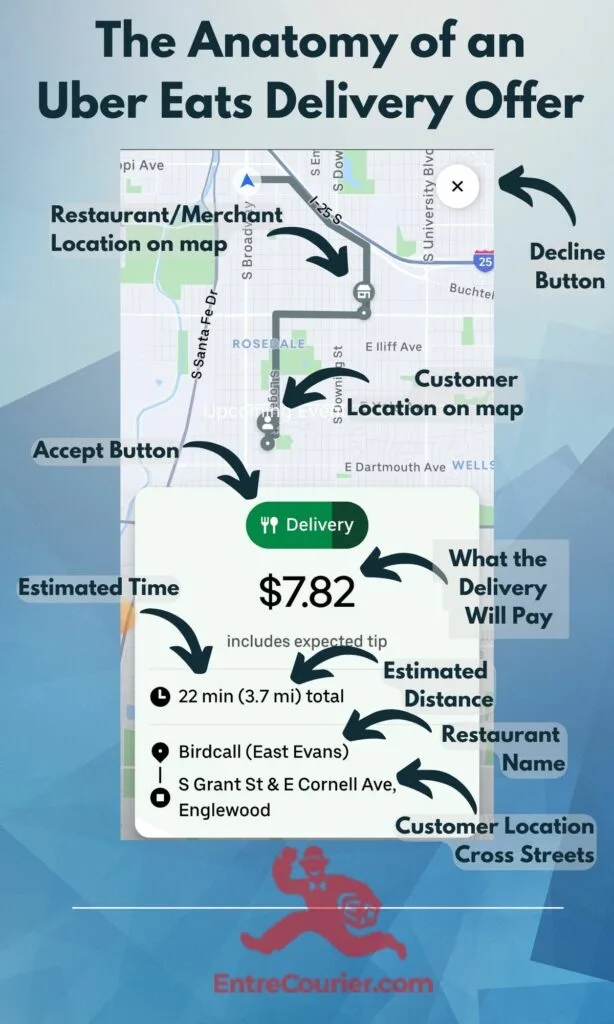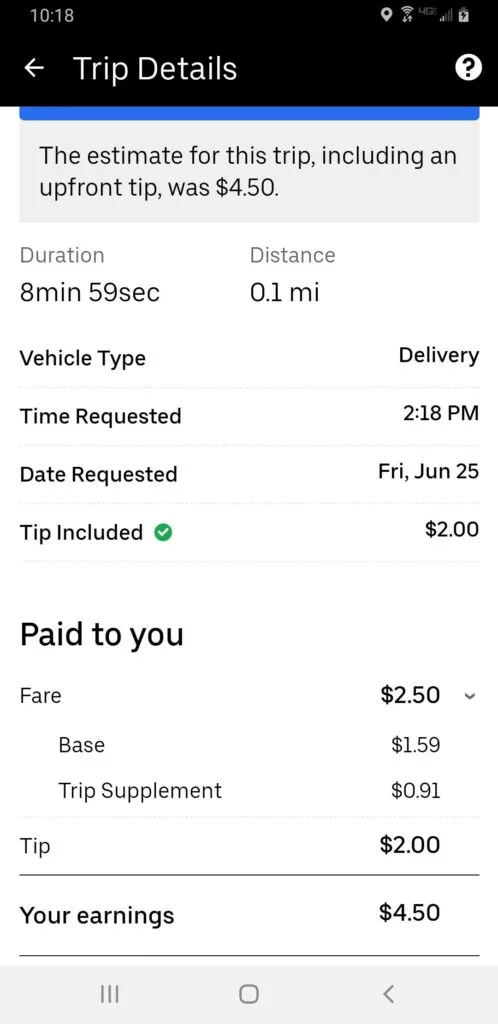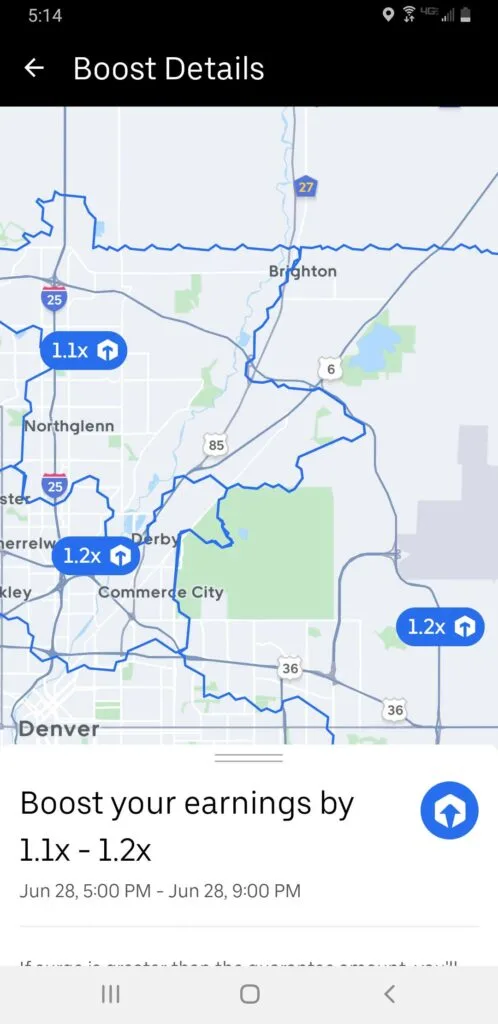If you are looking for an hourly rate for Uber Eats delivery or a salary, you won’t find it. If someone tells you that Uber Eats pays a certain amount, they don’t know how Uber Eats works.
The Uber Eats delivery platform pays on a delivery-by-delivery basis. After nearly five years of delivering for Uber Eats, I can tell you that sometimes the pay is fantastic and sometimes terrible.
The critical question is, what would it be for you? How does it average out? Does Uber Eats pay well enough, and how can you tell what to expect?

How much do Uber Eats drivers make? There’s no one answer to that. I’ve often made over $30 per hour, yet I’ve seen many make less than $10 per hour. Uber Eats drivers are independent contractors, meaning there are many factors in what they can earn.
We’ll peek behind the curtain and see how Uber Eats pays drivers. The best way to figure out how much Uber Eats pays is to understand how the pay model works and the factors that impact the earnings rate. This will give you a better idea of what to expect.
- What are some drivers earning with Uber Eats?
- How Uber Eats contractors are paid
- The Uber Eats Pay Model: Four factors that make up the payment
- Two additional factors that impact Uber Eats pay rate
- How you can use these six factors to boost your earnings.
- Is Uber Eats worth it?
- Frequently Asked Questions about Uber Eats Income
About this article:
This article focuses on how much money Uber Eats drivers make in the United States. Uber Eats does operate in many countries, and the pay model and local circumstances can vary from one nation to another.
This is part of a series of articles on being a delivery driver for Uber Eats. We’ll link to other articles that go into more detail about the given topic. You can also see a list of the other articles at the end of this one.
What are some drivers earning with Uber Eats?
Some will tell you that you can expect less than minimum wage. Some job sites quote mid $40k ranges for full-time drivers.
Who’s right? Which one is it?
Both can be and often are true, even for drivers in the same market.
The critical thing to understand here is there is no salary or hourly pay for Uber Eats drivers. That’s because delivering for Uber is not a job but an independent contractor position. You provide package and food delivery services for Uber Eats as a business, not as an employee.
Sam Lyon gained notoriety a while ago on TikTok as he documented his deliveries for twelve hours a day for a month. He earned over $8,300, a pace that would exceed $100,000 per year.
There’s a lot of argument about what drivers really make. A perfect example of this was when Uber CEO Dara Khosrowshawhi tweeted about his experience doing some Uber Eats deliveries.
He posted that he earned $98.91 in about 3.5 hours. However, Yahoo Finance reported it, saying he revealed drivers barely make minimum wage. They later amended their headline.

The truth is earnings vary a lot. And they’re not always what they look like.
This is because many drivers don’t consider the cost of driving their personal vehicles for deliveries. Uber Eats does not reimburse for driving, meaning contractors pay those costs out of pocket.
One source I saw notes that the national median, as of early 2024, was $17.74. The median isn’t average, but it’s the middle. There was the same number who made more and who made less than that amount.
There are a lot of extremes on both sides. Much of it depends on the following factors.
How Uber Eats couriers are paid
The first part of learning what Uber Eats drivers can make is understanding how pay happens.
I mentioned earlier that drivers are paid by the delivery. Once a delivery is completed, the driver receives payment.
Here’s how it works:
On the driver app, Uber Eats offers delivery requests to a contractor with the opportunity to accept or reject it. The offer includes what the delivery is expected to pay, including the customer’s tip.

If the Uber delivery driver accepts the offer, they get paid once the delivery is completed. Payment is made through a deposit into a virtual wallet on the driver app. There are various ways the driver transfer payment to their bank account from that virtual wallet.
The Uber Eats pay model: Four things that determine what you get paid for a delivery
Here’s the critical thing to understand: Uber Eats does not pay a wage, salary, or hourly rate because drivers are not employees.
I think Kevin at FinancialPanther.com said it best. You are not trading time for money with any of these food delivery apps. Instead, you trade tasks for money. Complete a delivery, and receive payment. It’s as simple as that.
Understanding how the payments work with Uber Eats gives you a better feel for what you can make. You also know the things that you can control to increase the amount of money you can make.
The Uber Eats pay model boils down to four things:
- Base pay
- Trip Supplement
- Incentives
- Customer Tips.
The payment you receive from Uber Eats for a completed delivery will include the base pay, and possibly one or more of the other factors.
1. Uber Eats base pay.
Uber Eats calculates their delivery fares based on how far you have to go and how much time it takes.
Unfortunately, they don’t tell you how they calculate that payment.
Once upon a time, they used a very transparent formula.
- A pickup fee
- A drop-off fee
- A per-mile payment (from the restaurant to the customer’s location, actual miles)
- A per-minute fee (from arrival at the restaurant to the time you drop off).
Uber Eats still calculates the base pay on those factors. Unfortunately, they do not let us know the formula.
That means that the longer you drive from local restaurants to the customer or the longer it takes, the higher the base fare. In my experience, Uber Eats is much better at adjusting the payment based on time and distance than Doordash and Grubhub. The screenshots below show how pay varies based on time and distance.

The pay summary above shows a very short, quick delivery. The customer was only a block from the restaurant, and the delivery took less than 9 minutes. The base pay on this delivery was only $1.59.

By comparison, this screenshot was for a long trip, 8.4 miles and 21 minutes. The base pay was $4.69, nearly three times as much as the shorter, faster delivery.
Uber Eats no longer publishes the base pay formula. However, I had a weird anomaly show up on one summary.

Doing the math, the pay broke down to:
- 35-cent dropoff fee
- 74-cent pick-up fee
- 30 cents per mile
- 5 cents per minute.
This was from a Summer 2020 delivery. I found the numbers to be consistent with other deliveries for several months. However, starting in the fall of 2021, base pay averaged 35% lower than what this formula would have totaled.
2. Uber Eats Trip Supplement.
Uber Eats sometimes adds an element to the pay called a trip supplement. It’s the wildcard in the Uber Eats pay model, allowing Uber to pay whatever they need to in order to get a delivery offer accepted.
Uber often has a minimum pay for a market. The trip supplement makes up the difference if the base pay is lower than the minimum. You can see that in the first pay summary shown above, where Uber added a 91-cent supplement to meet the $2.50 minimum.
When the trip supplement was introduced in late 2019, Uber said its purpose was to “make earnings for each trip more reflective of that trip.”
This sounds similar to Doordash’s desirability factor in their pay. If they don’t think a delivery person will accept a delivery offer, this wildcard lets them bump up pay to make it more attractive.
3. Uber Eats Incentives.
Uber Eats offers incentives to get drivers out to deliver during peak hours. In the same way that the trip supplement can be adjusted to make an individual delivery offer attractive, incentives encourage drivers to log in when there is high demand.
Uber can not set schedules or require contractors to accept particular delivery orders, as they’re not allowed to control those factors for gig workers. Instead, they have to find other ways to fulfill their delivery obligations.
One way to encourage drivers to get out is to offer extra money. Uber does this in three primary ways that we’ll discuss. This is not a complete list. You may see one, two, or all three of these at any particular time. When things are slow, they may not offer any of them.
Boosts
An Uber Eats boost promotion multiplies the base pay for drivers in a particular part of a market during certain times.
Uber forecasts when they expect higher demand and may offer boost incentives accordingly. Boost multipliers are a factor multiplied against the base pay earned for food orders..

The screenshot above is from the Promotions calendar in the Uber Driver app. You’ll see that boosts are planned for Monday from 5 to 9 PM and Tuesday from 4 to 8.
The number in the boost is the multiplier. A 1.1 boost means that you multiply the base pay by 1.1.
The boost is only multiplied against the base pay. Trip supplements, incentives, and customer tips are not increased by boost promotions.

The map above is a screenshot from the Uber app that shows the boost zones available in the different parts of the city. The blue lines on the map identify the boundaries for each boost zone.
Because the base pay is frequently $2 or less, boost promotions don’t often add much to a trip. A 1.2 boost only adds $0.24 to a delivery with $2 base pay.
Surges
Another promotion that adds extra pay to the delivery is called a surge.
Surge pricing is different than a boost, in that it adds a flat rate dollar amount to each delivery (compared to the boost’s percentage of the base pay).
For instance, $2 surge prices add a two-dollar bonus to complete orders.
Surges are similar to boosts in that they’re often offered during certain times and usually only offered in certain market portions.
Quests
Quests are promotions that reward drivers for completing a set number of deliveries in a particular period.

Like boosts, Quests are usually scheduled. They come in a number of shapes and sizes.
The above screenshot shows a $10 quest for five deliveries over four days. The bonus increases to $20 for completing 10 trips, $30 for 15 trips, and up to $80 for 40 trips.
Smaller quests may be only for a matter of hours. Payment for successful quests is made once the final delivery is completed.
In some instances, I was allowed to choose my quest. Uber once offered several options, allowing me to decide how many deliveries I wanted to attempt for a weekend.
Quests have been the best of the three promotions, in my experience. They usually offer a more significant per-delivery bonus than boosts or surges.
4. Customer tips.
Customers can tip delivery drivers in one of three ways:
- Customers can include the tip when placing the order.
- They can add a tip through the Uber Eats app up to an hour after the delivery is completed.
- Customers can can give you a cash tip when you deliver.
Most tips on Uber Eats happen when the customer places the order. When that happens, the tip is included in the offer amount when a delivery is offered to the food delivery driver.
Tipping was terrible when I started delivering for Uber Eats at the beginning of 2018. When Uber began with their ride service, they discouraged tipping the rideshare drivers, explaining that drivers were paid well enough that a gratuity was unnecessary.
That attitude rolled over into delivery. However, Uber Eats has become much better at encouraging customers to leave a tip, and tips are a substantial part of overall pay.
Two additional factors that impact Uber Eats earnings rate
The payment you receive for Uber Eats deliveries is from the pay model’s four factors that we just discussed.
Two additional factors influence your overall earnings rate.
- The amount of time it takes to complete deliveries
- The cost of performing the deliveries
Time
How quickly can you get the delivery completed?
Because here’s the thing: You get paid what you get paid for any given delivery. However, if you can get more deliveries done in a given time, that’s more money that you make.
Let’s say the average payment per delivery is $10. If you can complete two per hour, that’s a $20 hourly rate. Three deliveries in an hour bump you up to $30/hour, and four hourly deliveries nets you $40.
Faster, shorter deliveries mean more deliveries per hour. You can complete more food deliveries if you can avoid wait times at restaurants. Shop and deliver orders take more time than simply picking up a package.
I said earlier we trade tasks for money. The more such tasks you can be paid for in the total time spent on deliveries means more money.
During the pandemic shutdown, I noticed I was making more money. However, payment per delivery wasn’t increasing. Looking into it further, I discovered that I was completing deliveries more rapidly and efficiently because of the lack of traffic. The shorter actual time spent increased my driver pay tremendously.
Expenses.
As an independent contractor, you provide services for Uber Eats as a business. The IRS treats you as a business on your Uber Eats taxes.
Because you’re operating a business, you’re on your own for the cost of doing so.
Why’s this important? When you’re running a business, the money you get from Uber Eats and customer tips is NOT what you earn. This isn’t the same as an Uber Eats paycheck.
When all is said and done, what you earn is the amount left over after expenses. If you spent more completing deliveries than you earned, you never really made any money.
Driving your car for deliveries is a significant expense. It’s a cost that goes far beyond fuel costs. Every mile gets you closer to replacing tires or a timing belt, and each mile reduces the resale value of your car.
You must know how much it costs to use your car. It’s rare to total out less than 30 cents per mile.
The factors in the pay model increase your earnings. Expenses reduce them.
Measure your earnings as profit per hour.
Here’s where you add it all up.
Add your total base pay, trip supplements, incentives, and tips. Then subtract the cost of driving.
Divide that by the time you spent delivering to determine your profit per hour.
Profit per hour is the best measurement of your earnings. It allows you to compare how you did for one day to profit per hour for a single delivery or an entire year. It’s also a better number to help you determine what you really made.
How can you use these six factors to boost your profits?

The key is figuring out how to have the most possible money left over after expenses in the time you can devote to Uber Eats deliveries.
Understanding the earnings factors helps you weave them together with the time and expenses to increase your profitability.
Some of these earnings factors work against one another. When base pay is based on time and distance, you realize that chasing a higher base means it takes more time and costs you more.
In other words, it’s counterproductive to go after deliveries that take more time simply because they pay more. Additional pay for longer distances often doesn’t justify the extra time and cost.
Additional pay from incentives can be great, but if all the other Uber Eats delivery drivers are logged on to chase those incentives, it can leave you waiting longer between offers.
The point here is not to zero in on any particular pay factor. Instead, the key is to work on the best combination of pay factors to help you out.
In my experience, the estimated time to deliver is the most important factor for me. Uber Eats provides an estimate on the offer screen that’s pretty accurate. You can compare that to pay to get a feel for the hourly rate you can make on a delivery.
The critical lesson here is to look at the big picture.
There are many tips to help you earn extra income. Learn the best times to deliver for Uber Eats, Accept and decline your Uber Eats delivery offers wisely. We have a comprehensive guide on making more money with Doordash deliveries. Most (if not all) suggestions can be applied to Uber Eats deliveries and for other delivery platforms.
Is it worth it to deliver Uber Eats?
That all depends on you, your market, and how it works for you.
For me, Uber Eats has been very worthwhile. However, let me be clear: I do not deliver for Uber Eats exclusively (and probably never will). I look at them as one of several customers for my delivery business. When Uber Eats offers the best delivery opportunities, they’re very worth it.
We discussed the factors determining how much you can make and how to measure total earnings. Other factors impact how much you can make:
- Is Uber Eats busy or slow in your market?
- Do customers tip well?
- Are there other alternatives in your market you can turn to if things are slow on Uber?
- Are there too many drivers logged in for the number of opportunities?
In my review of Uber Eats as a driver, I go into more pros and cons. Ultimately, for me it’s been very much worth it. However, you’ll have to decide for yourself based on what’s important to you.
Frequently Asked Questions about Uber Eats Income
Many of these questions are answered in the information above. However, I felt it would be helpful to include these questions. You may be able to get your questions answered more quickly here.
Delivery for Uber Eats is an independent contractor position, meaning there is no hourly wage. Instead, You are paid for each delivery upon completion.
Every once in a while, you may notice advertisements like the picture below. The ad is misleading. There are no hourly pay rates. Uber will often base things like this on the averages for your area. Payment is still delivery-by-delivery.
In my experience, yes. You have the right to make strategic decisions such as when to work, what areas to deliver, and which deliveries you accept. Delivery offers are nothing more than a bid for your services. Proper evaluation of those offers gives you a tremendous say in what you can make.
Money for your deliveries accumulates in your virtual wallet on the Uber driver app. As of the end of the day Sunday, money in the account is sent to your bank account by direct deposit.
Uber Eats processes your direct deposit on Mondays or on the first business day of the week. It usually arrives in bank accounts on Tuesdays, but the processing time can vary depending on the driver’s financial institution.
Uber Eats does have an Instant Pay feature, which allows you to immediately transfer your funds to your debit card. Uber charges a fifty-cent processing fee each time you cash out. Uber also has their own debit card, powered by Go Bank, that does not charge an Instant Pay fee. Drivers can cash out up to five times daily.
The number of hours you deliver is entirely up to you as an independent contractor. It is possible and sometimes profitable to deliver for Uber Eats full-time. Understand that you are not an Uber Eats employee and thus have no benefits or guarantees related to doing so.
Customers have up to an hour after the delivery to add a tip, edit it, or delete it. This does allow customers to tip bait, meaning they add a tip to entice a driver to accept their delivery, then remove it afterward. This has been a common practice on Instacart. I’m only aware of one time a customer ever changed the tip amount. Still, other drivers report that tip baiting happens frequently. Uber’s tip policy makes it possible for your actual pay to be less than was offered.
Uber Eats does not take a percentage of the pay that was offered to you. What you see offered is what you will get unless the customer changes the tip amount. However, Uber does claim you made more than what they paid you, saying the actual pay was higher and they kept a service fee. It is a paper transaction, and no money is taken from what you were offered.
No. There is no correlation between how Uber calculates what you are paid and what the customer pays. Uber Eats calculates your pay based on time and distance and not on what the customer pays.
Generally no. In February 2022 they added a fuel surcharge to customer orders. That practice ended within a couple of months even though prices continued to rise.
The Uber Eats Delivery Driver Series
A series of articles that cover all different aspects of delivering for Uber Eats as an independent contractor.
This is the overview article of the series, touching on each of the main topics that are covered in other articles.
We examine what it means to be a self-employed independent contractor for Uber Eats and how that compares to being employed.
Guidance on how to determine the best times and days to deliver for Uber Eats.
Five questions to ask to determine if delivering full-time makes sense, and eight keys to success if you do make that decisions.
How delivery opportunities are offered to Uber Eats couriers, their freedom to accept or reject, and tips for making good decisions.
How taxes work for independent contractors who deliver for Uber Eats. This is the first article of a series related to Uber Eats tax issues..
A review about how delivering for Uber Eats works, and pros and cons of working with Uber Eats as an independent contractor.









